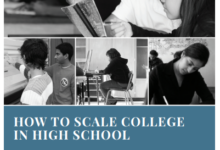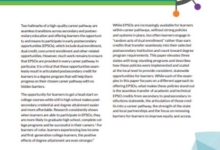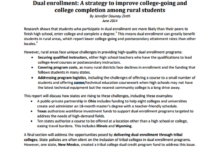In 2013, Vermont launched the Flexible Pathways Initiative through Act 77 to provide more flexibility for school districts, promote college readiness through personalized pathways, and increase graduation rates and postsecondary completion. Significantly, the law allows school districts the flexibility to develop more innovative CTE programs and provide students a clear path to graduation.
The opportunities within Act 77 hinge around the development of a personalized learning plan. Students in grades 7-12 create learning plans that draw on their emerging abilities, aptitudes and dispositions to inform course-taking and educational opportunities. Each plan is developed in consultation with the student’s’ parent or guardian and is largely based around the student’s academic and career interests. Under the policy, Vermont students can build their personalized learning plans using a menu of alternative graduation pathways, including work-based learning, CTE, dual enrollment, early college programs and more.
Following the legislature’s lead, the Vermont State Board of Education updated its Education Quality Standards in 2013 to adopt new graduation flexibility and provide schools considerable leeway in determining what and how students learn. Under the new rules, alternative educational experiences could count towards a secondary diploma as long as:
- Learning is supervised by a licensed educator;
- Students demonstrate competency in the Board’s core quality standards (which include literacy, mathematical content, scientific inquiry, global citizenship, physical education, artistic expression and transferable skills); and
- Student learning is measured through performance-based assessments such as teacher-or student-designed assessments, portfolios, performances, exhibitions and projects.
These new requirements create sufficient space for CTE to thrive. Under the legislation, CTE and work-based learning can be included as components of the personalized learning plan, allowing students to count technical and professional skill development towards a high school diploma. The Board also requires schools to provide students with information and counseling to promote student opportunities for CTE and work-based learning. Furthermore, students can apply CTE credits and experiences towards a high school degree through performance-based assessments.
To that end, the state has developed a performance-based framework to help districts measure students’ transferable skills. Transferable skills, which are included in the Board’s Education Quality Standards, are designed to measure “21st century” competencies that students need to be successful in college or their future careers. The framework identifies performance indicators related to five graduation proficiencies:
- Clear and effective communication
- Self-direction
- Creative and practical problem solving
- Responsible and involved citizenship
- Informed and integrative thinking
The Flexible Pathway Initiative also allows secondary students to pursue and attain college credit while in high school through dual credit courses and early college high schools. Under the program, eligible high school students can take up to two college-level courses tuition free (individual districts can offer additional dual credit opportunities if they are willing to cover the costs). The legislation also authorizes the Department of Education to pay for part of an early college high school program that allows students to complete their first year of postsecondary education while simultaneously earning credits towards a high school diploma. There are seven state-approved early college high schools in Vermont, including the Vermont Academy of Science and Technology (VAST), which partners with Vermont Tech to create a rich early-college learning environment for high school students.
Policy in Action
The Flexible Pathways Initiative continues to demonstrate promising outcomes. In school year 2014-15 (the second year of program implementation), more than 2,100 Vermont students took advantage of dual credit opportunities, compared to only 600 before the program was launched. The state also saw a marginal increase — from 380 in 2013 to 434 in 2014 — in the number of students taking advantage of Fast Forward, a dual credit program for students enrolled at CTE centers. In the future, the Department of Education plans to evaluate the dual credit program based on outcomes metrics such as student performance on dual credit coursework, postsecondary enrollment rates and postsecondary retention.
Additionally, schools are taking measures to prepare staff to coordinate work-based learning experiences for learners. These individuals help establish relationships with local employers, place students in work-based learning opportunities related to their program of study, and help them integrate academic and technical competencies into the worksite experience. Endorsements for work-based learning coordinators increased from 38 to 53 between fall 2016 and summer 2017, according to reporting from the Hechinger Report.
Related Links
- Full text: S130 (2013)
- State Board Rule: Series 2000 – Education Quality Standards (2013)
- Report: Report on Act 77 of 2013 (2018)
- The Hechinger Report: In One State, Students are Ditching Classrooms for Jobs (2017)
Last updated: August 2021






